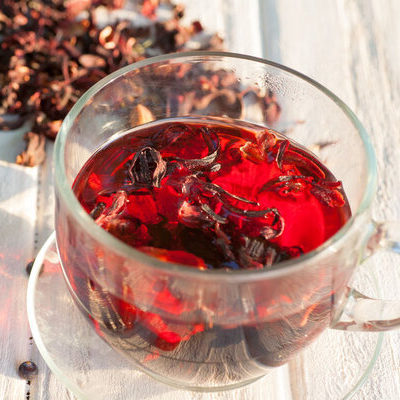
Hibiscus Tea
also known as Karkade, Bissap, Roselle Juice, Agua de Jamaica, Sour Tea
What is Hibiscus Tea?
Hibiscus tea is a warm infusion made from brewing dried hibiscus, or roselle flowers, together with water.
- The hibiscus plant (Hibiscus Sabdariffa) originated in North Africa and Southeast Asia but now grows in many tropical climates.
- This herbal tea is naturally caffeine-free and is recognizable for its deep red color and floral scent.
This herbal tea can be consumed hot or cold with two popular cold varieties including Bissap (Senegal) and Agua de Jamaica (Mexico). The flavor of this tea is not sweet, but more tart like cranberry juice.
Some common varieties of edible hibiscus include:
- Jamaican Sorrel (Hibiscus Sabdariffa)
- Cranberry Hibiscus (Hibiscus acetosella)
- Edible Leaf Hibiscus (Abelmoschus manihot)
Origin of hibiscus tea
Ancient Egyptian Pharaohs were believed to have consumed hibiscus tea in its cold form as a way to cool off in the desert. The hibiscus plant has been used in Egypt and Sudan for hundreds of years, where it is also known as “karkade”. However, the first known notes about the Hibiscus Sabdariffa plant were from a botanist named Matthia l’Obel in 1576. Historians suggest that this plant made its way to the Western World on slave ships and soon the plant was cultivated in the Caribbean, Mexico, Guatemala, Florida, and Hawaii.
By 1892, in Queensland, Australia there were two factories producing roselle jam made from hibiscus tea. During the 19th century, the hibiscus plant would also be introduced to West Africa, specifically Senegal where it would become an important crop. In Senegal, this herbal tea is known as bissap and is commonly consumed at parties, weddings, and special occasions. From the 1950s onward the hibiscus plant and karkade would become popular in many tropical and subtropical climates for their many benefits and uses. Today, this drink is called my many names all over the world, but still recognized for its unique red color and tart taste.
Nutrition
Karkade has been used in African countries and Iran for its many health benefits. A medical study shows that this tea helps lower blood pressure. Research has also shown that drinking this tea as opposed to black tea can help maintain healthy cholesterol levels. Other studies have also illustrated hibiscus tea’s ability to manage body weight. The antioxidants and anthocyanin compounds in this tea are also attributed to improved heart health.
However, while there are several health benefits from this herbal tea there are also possible side effects caused by overconsumption. Drinking too much karkade can affect medications, lead to liver damage, and is not considered safe for women who are breastfeeding. Individuals taking medication for malaria or high blood pressure should avoid consuming this tea.
Commercial Production
The commercial production of herbal tea first begins with collecting the herbs, which is this case is the roselle or hibiscus flower. Then, the plant material is transported to a factory for sorting, washing, and disinfecting. Next, the plant material is dried and prepared for packaging. If the hibiscus tea is distributed in tea bags, there is an additional step of grinding which happens before packaging. Finally, the tea is shipping off for distribution.
Uses
To enjoy this herbal tea to the fullest, you should take care to store it properly. While dried leaves have a long shelf life, they should always be stored in a dry, dark space away from heat. If the tea comes prepackaged, keep it in its original container or packaging. Loose tea should be kept in a ceramic airtight container or tin and while you can also use a glass jar, ensure that the tea is stored away from light. If stored correctly, karkade can stay fresh for a maximum of two years.
Hibiscus tea recipes
This herbal tea can be prepared in a variety of ways. Here are some popular recipes:
FDA Regulation
The Food & Drug Administration regulates the polymers most commonly used in tea bags or infusers. However, the other aspects of herbal tea production such as importation and packaging are strictly regulated by the USDA. Furthermore, the USDA regulates instant tea mixes. In 2019, the FDA sent an advisory letter to a company that was marketing hibiscus tea as a treatment for serious diseases. Making health claims which are not backed by research or science is a grave concern for the FDA as this can lead to health issues in consumers who are misled by illegal marketing.
References
Morton, J. “Roselle – Hibiscus Sabdariffa L.” Hort.purdue.edu, Purdue University, 1987, www.hort.purdue.edu/newcrop/morton/roselle.html.
“What Is Hibiscus Tea?” The Republic of Tea, The Republic of Tea, 23 Sept. 2020, the.republicoftea.com/tea-library/herbal-tea-and-tisanes/what-is-hibiscus-tea-2/.
“What Is Hibiscus?” Teatulia, Teatulia, www.teatulia.com/tea-varieties/what-is-hibiscus.htm.
Megan, Ware. “Hibiscus Tea: Health Benefits and Risks.” Medical News Today, MediLexicon International, 19 Mar. 2018, www.medicalnewstoday.com/articles/318120.
